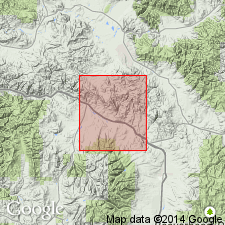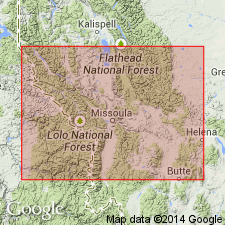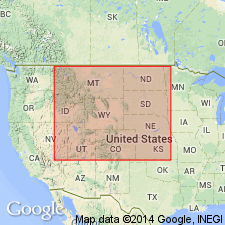
- Usage in publication:
-
- Coberly formation
- Modifications:
-
- Named
- Dominant lithology:
-
- Limestone
- Sandstone
- AAPG geologic province:
-
- Montana folded belt
Summary:
Named as a formation of the "upper Colorado group" for Coberly Gulch, Powell Co, MT, Montana folded belt province. Type section is a composite of N1/2 sec 21 (upper 310 ft) and E1/2 sec 8 (lower 260 ft), T10N, R11W. Composed of fossiliferous gray limestone and tan, salt-and-pepper sandstone. Sandstones are massive and locally form sharp ridges. High-spired snail shells and oyster fragments found throughout unit. Deposited in intertidal and shallow-marine water. Same fossils found in upper part of Greenhorn formation. Is probably equivalent to Cone calcareous member of Marias River shale. Overlies Dunkleberg member (new) of Blackleaf formation. Underlies Jens formation (new) of "upper Colorado group." Of early Late Cretaceous age.
Source: GNU records (USGS DDS-6; Denver GNULEX).

- Usage in publication:
-
- Coberly Formation*
- Modifications:
-
- Age modified
- Overview
- AAPG geologic province:
-
- Montana folded belt
Summary:
Occurs in area of Drummond, Granite Co, MT and Anaconda, Deer Lodge, Co, MT, south of Lewis and Clark line (a west- and northwest-trending fault zone in west-central MT), Montana folded belt province. Unconformably overlies Blackleaf Formation; conformably underlies Jens Formation. Consists of interbedded bioclastic sandy limestone and carbonate-bearing fossiliferous sandstone deposited in shallow brackish-water. Base of unit is latest Cenomanian or early Turonian age and uppermost beds are middle Turonian age (W.A. Cobban, written communication, 1977). [Fossils used in age determination not specified]. Correlates in part with Floweree, Cone and Ferdig Members of Marias River Shale in Wolf Creek area on north side of Lewis and Clark line in Lewis and Clark and Cascade Cos, MT.
Source: GNU records (USGS DDS-6; Denver GNULEX).

- Usage in publication:
-
- Coberly Formation*
- Modifications:
-
- Age modified
- AAPG geologic province:
-
- Montana folded belt
Summary:
Two specimens of ACTINOCAMAX found in upper part of Coberly Formation in Hoover Creek 12 mi southeast of Drummond in NE1/4 sec 17, T10N, R11W, Powell Co, MT in the Montana folded belt province. These marine fossils are known only from ammonite zone COLLIGNONICERAS WOOLLGARI of early middle Turonian age. Discovery of the belemnite aids in dating the marine transgression in central western MT. The oyster RHYNCHOSTREON SUBORBICULATUM was found in sandstone in the upper part of the Coberly nearby in sec 31. The belemnite and oyster have been found in association at many localities in KS, SD, CO, UT, WY, and elsewhere in MT. The calcareous middle unit of Coberly has brackish-water fossils (oysters, gastropods); it was probably deposited in a bay or lagoon. The underlying middle unit of the Coberly is probably equivalent to the Bridge Creek Member of the Greenhorn Limestone. The middle unit also has a conspicuous unnamed white bentonitic bed, perhaps equivalent to a 1 m thick bentonite in northwest and east-central MT. This bentonite is thought to be the same as one found in Alberta. Invertebrate burrows have been found in basal unit.
Source: GNU records (USGS DDS-6; Denver GNULEX).
For more information, please contact Nancy Stamm, Geologic Names Committee Secretary.
Asterisk (*) indicates published by U.S. Geological Survey authors.
"No current usage" (†) implies that a name has been abandoned or has fallen into disuse. Former usage and, if known, replacement name given in parentheses ( ).
Slash (/) indicates name conflicts with nomenclatural guidelines (CSN, 1933; ACSN, 1961, 1970; NACSN, 1983, 2005, 2021). May be explained within brackets ([ ]).

